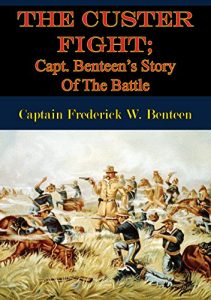FOR THE FIRST TIME since he testified before the Reno Court of Inquiry, at Chicago, in 1879, Capt. F. W. Benteen, senior captain of Custer’s regiment, the famous 7th Cavalry, here relates the part he played in that most disastrous of Indian fights on American soil, over which more controversy has raged than over any other battle fought against the red man in the United States.
Much of the account is from his own testimony at the Reno Inquiry; some of it is from the personal letters of Capt. Benteen, (in possession of the author). Certain charges were made against Major Marcus A. Reno and Capt. Benteen by Frederick Whittaker, Custer’s biographer. At the last moment Whittaker withdrew his charges against Capt. Benteen. He also utterly failed to substantiate his charges against Major Reno, the verdict of the Court being that “there was nothing in his conduct which requires animadversion from the Court, and that in view of all the facts in evidence, no further proceedings are necessary in this case.”
No officer in the Civil War won a more brilliant record than Major Reno, he being brevetted by grades from a first lieutenant to a colonel ‘‘for gallant and meritorious service.” Later, he served as Assistant Instructor of Infantry Tactics at the U. S. Military Academy at West Point.
The testimony at the Reno Inquiry revealed that both Capt. Benteen and Major Reno had done the best that could be done with what they had to do with, and that, but for their extraordinary heroism and bravery in the fight on the bluffs, following Custer’s overwhelming defeat, four miles down the river, the troops under their charge would likewise have been wiped out.
Capt. Benteen’s testimony and extracts from his letters proves absolutely that Custer had formed no battle plans at the time he made his battalion assignments; or, if he had such plans, he did not reveal them to either Major Reno or Capt. Benteen.
While the numbers of the attacking Indians has been variously estimated at from 1,500 to 4,500, Capt. Benteen states that, in his opinion, they numbered 8,000 or 9,000.
Students of the battle of the Little Big Horn will do well to carefully preserve this account of the Custer fight as related by Capt. Benteen.
Much of the account is from his own testimony at the Reno Inquiry; some of it is from the personal letters of Capt. Benteen, (in possession of the author). Certain charges were made against Major Marcus A. Reno and Capt. Benteen by Frederick Whittaker, Custer’s biographer. At the last moment Whittaker withdrew his charges against Capt. Benteen. He also utterly failed to substantiate his charges against Major Reno, the verdict of the Court being that “there was nothing in his conduct which requires animadversion from the Court, and that in view of all the facts in evidence, no further proceedings are necessary in this case.”
No officer in the Civil War won a more brilliant record than Major Reno, he being brevetted by grades from a first lieutenant to a colonel ‘‘for gallant and meritorious service.” Later, he served as Assistant Instructor of Infantry Tactics at the U. S. Military Academy at West Point.
The testimony at the Reno Inquiry revealed that both Capt. Benteen and Major Reno had done the best that could be done with what they had to do with, and that, but for their extraordinary heroism and bravery in the fight on the bluffs, following Custer’s overwhelming defeat, four miles down the river, the troops under their charge would likewise have been wiped out.
Capt. Benteen’s testimony and extracts from his letters proves absolutely that Custer had formed no battle plans at the time he made his battalion assignments; or, if he had such plans, he did not reveal them to either Major Reno or Capt. Benteen.
While the numbers of the attacking Indians has been variously estimated at from 1,500 to 4,500, Capt. Benteen states that, in his opinion, they numbered 8,000 or 9,000.
Students of the battle of the Little Big Horn will do well to carefully preserve this account of the Custer fight as related by Capt. Benteen.






